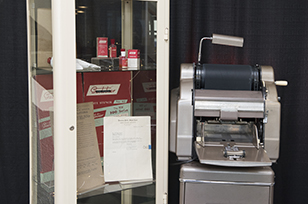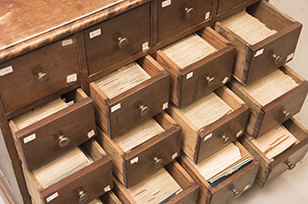Page Content
Among the most cherished of the Association’s artifacts is the academic robe ordered for founder John Barnett to wear while accepting an honorary doctor of law degree from the University of Alberta.
Approaching anniversary prompts rare display of Association artifacts
If you’ve visited Barnett House in recent weeks, you probably noticed something new: tastefully arranged artifacts on display throughout the foyer and cafeteria areas.
To commemorate the Alberta Teachers’ Association’s 100th anniversary, a selection of special items from the organization’s archives are being displayed. It’s the first time that artifacts from the Association’s archives have been showcased in such an orchestrated, ongoing fashion, said archivist Margaret Shane.
“Some of these things have never seen the light of day since they entered the archives,” Shane said.
Throughout 2017 and into 2018, Shane and her staff will be rotating different archival items through the various display cases at Barnett House. Shane is hoping that the effort will engender conversation and help Association members and staff connect with the history of the organization, which came into official existence in 1918.
“It’s always a frustration for archivists to have all this tremendous stuff and not form connections between our contemporaries and their history,” Shane said. “There’s nothing like the tangibility of an artifact to create that connection.”
The robe never worn
Among the most cherished of the Association’s artifacts is the academic robe ordered for founder John Barnett to wear while accepting an honorary doctor of law degree from the University of Alberta.
Tragically, Barnett died suddenly at the age of 66 a few months before he could accept the degree. While the university bestowed the degree posthumously at its convocation ceremony in the fall of 1947, no one has ever worn the robe and hood, nor have the items been previously displayed.
“I think this is the saddest artifact that we have in the archives,” Shane said. “I figured for the 100th anniversary, it was time to haul them out and for people to have a look at them and share in wondering what might have been.”
Made by Harcourt’s in Toronto, the robe and accompanying hood are crafted from heavy wool and felt. They are currently in a wall-mounted display case in the Barnett House cafeteria.
ATA Magazine
Featured in a nearby case are several enlargements of pages from the first edition of the
ATA Magazine, published in June 1920, the cover of which was a call to arms that Barnett wrote asking “fellow teachers” if they were members of the ATA.
“If not, do you know that you are a
clog on the efforts of three-fourths of your fellow-workers in this Province?” the message states.
“He was making sure that teachers understood it was absolutely necessary for them to become involved and to join the ATA, which was a voluntary organization at the time,” Shane said.
In 1911, Barnett moved to Alberta from England, where he had been a member of the National Union of Teachers. When he arrived in Alberta he was appalled at the teaching conditions he encountered.
“He discovered how teachers were not given the full respect they deserved as educated professionals,” Shane said. “He decided that he was going to fix that, and he did.”
As well as Barnett’s call to action, the first edition of the
ATA Magazine also featured the earliest printed record of the ATA motto: Magistri Neque Servi (masters not servants).
The other two enlarged pages that are on display are full-page advertisements.
One ad, for Premier Cycle Works in Calgary, extolls the virtues of the “healthful exercise” of the Red Bird bicycle.
“Necessary to everyone who is confined to a school-room a greater part of the day,” the ad states.
The other ad, for the School Grafonola and Records, extolls the virtues of music in the classroom.
“It can assist you in every department of your school work and it can make for greater efficiency, better results and a much happier school life for Teachers and Pupils,” the ad states.
Shane said that both these ads relate to issues teachers faced during the inception of the Association, which was originally named the Alberta Teachers’ Alliance.
“They were concerned about health and wellness, the arts and music,” Shane explained. “If you go back and read the ATA Magazine from that time, a lot of the things the teachers were concerned about then, we are still concerned about now.”
Highly accomplished, fast-talking teacher
Also on display are several certificates that once belonged to teacher Dorothy Maxine Chase, who taught in Alberta in the early 1920s.
Included in the collection are Chase’s high school entrance certificate from 1920, her teaching certificate from 1925 and a favourable school inspector’s report dated April 6, 1925.
“A teacher who shows initiative who is sincere and interested in the pupils. Inclined to speak too fast,” the report states.
There are also several certificates documenting Chase’s progress and proficiency with the MacLean method of muscular movement handwriting.
Chase’s membership with the ATA was elective, as mandatory membership did not exist at the time she was a teacher.
“She chose to send us her $6 a year, or $0.50 a month, to be protected by her local,” Shane said.
Chase would have taught several grades in a one-room school house. Part of her duties would have been to establish a welcoming environment.
“She would have had to start the fire in the morning, saddle horses in the afternoon if the kids weren’t able to do it themselves,” Shane said. “She would have been responsible for supervision of their welfare throughout the entirety of their day.”
Chase would have had to provide her own teaching resources and she would have been paid by her school board’s ratepayers (i.e., local residents) and not the government.
“I am thrilled to be able to celebrate Maxine, and all the Maxines that were out there,” Shane said. “It is wonderful to have the nearest hint of what time travel might be like, to go back to 1924 and to be there with Maxine and her five students.”
Cranky machine

And what would a glimpse of education history be without a sampling of ancient teaching technology?
Long before anyone had thought of the photocopier, the Gestetner duplicating machine enabled users to turn a handle and pump out worksheets, lessons or newsletters.
“The Gestetner was a workhorse in Alberta schools well into the 1970s when technology evolved,” Shane said. “The Gestetner is one of those pieces of technology that is rather unassuming to look at, but its presence in schools and its function were a godsend to teachers. It made it possible to take on duplication and make sure everyone was literally on the same page.”
The specimen owned by the ATA archives dates back to the 1950s and originally belonged to the Edmonton Public Teachers Local No. 37. When the local “modernized” in the 1960s, it sold the machine as surplus to a local teacher, who used it well into the ‘90s to reproduce his classroom materials. After the teacher’s death, his brother found the machine, complete with the original bill of sale, and donated it to the ATA archives.
“Any sane person would have said ‘no thank you, sorry for your loss,’ but I said ‘I will be there in half an hour with a truck — don’t give it to anybody,’” Shane said. “We are thrilled to have it.”
Coming soon

Later this year Shane will pull out of the archives a special piece of furniture — a credenza in which Barnett kept all the Alliance’s original membership cards. The drawers are still filled with hundreds of original membership cards, which list teachers’ names, their community and the year or years of membership.
“These are still used, actually, whenever we have genealogy or family historians who come to us,” Shane said.
Shane said the credenza is a vital piece of the Association’s past as it was first housed in Barnett’s home, whose den served as the Alliance’s headquarters for the first five years of its existence.
“This has gone everywhere the ATA has gone over its entire history.”
